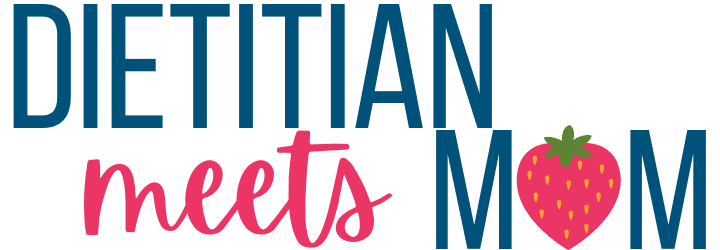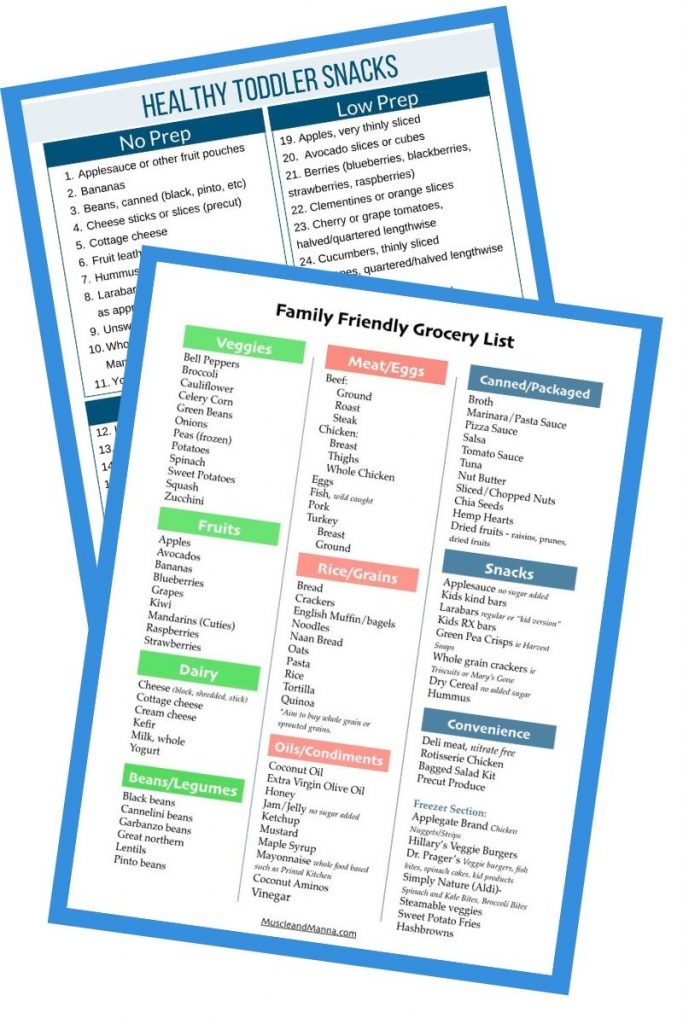Best Yogurt for Babies & Toddlers (+ Flavoring Plain Yogurt)
Do you feel overwhelmed when searching for the best yogurt for babies and toddlers? Do they need baby yogurt or will regular yogurt suffice?
I’ve set out to answer all of your questions about yogurt for babies including greek vs regular, what is different about “baby yogurt”, organic, and more!
This post may contain affiliate links. If you click & make a purchase, I receive a commission! Read my full disclosure policy.
This article was originally published on June 19, 2020 and updated with current info on May 12, 2021.
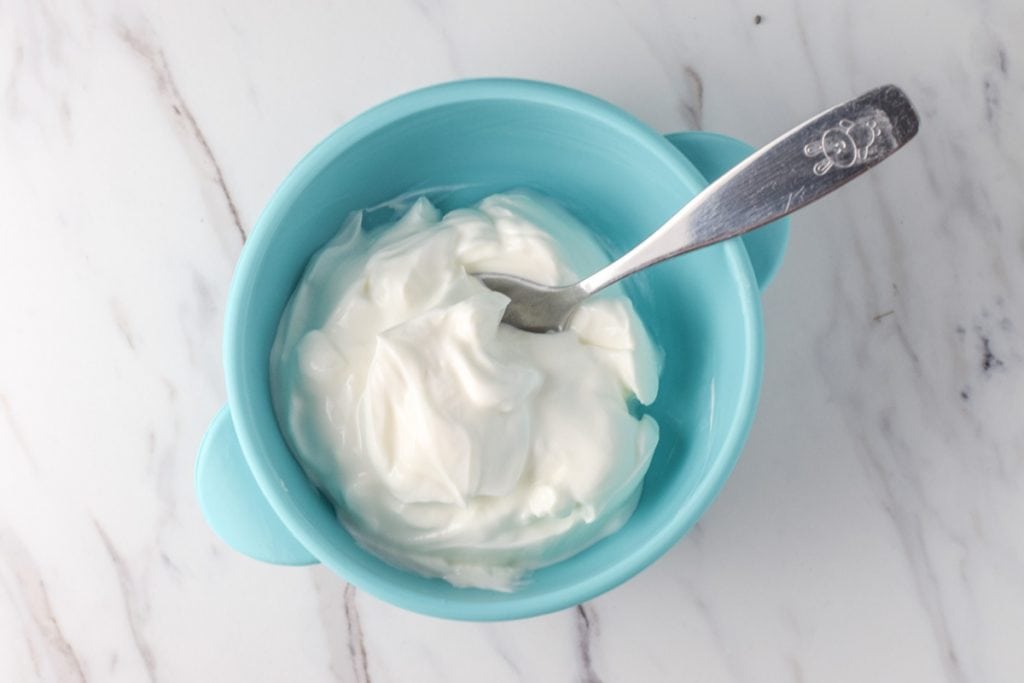
Baby Yogurt vs Regular Yogurt
Have you seen those products marketed as “baby yogurt?” Is it really necessary to buy this special baby yogurt? What makes it baby yogurt anyway?
Baby yogurt is basically the same as regular yogurt. It’s generally just packaged in a smaller container. A combination of marketing tactics and convenience make those little cups with a baby face so popular for busy parents. Many baby yogurts are actually sweetened with added sugar which is something your baby does NOT need.
So, whether you buy “baby yogurt” or just regular yogurt, the most important factor is to check ingredients to ensure you are buying the best choice for your baby.
Choosing The Best Yogurt for Babies and Toddlers
So what kind of yogurt is good for babies? Babies and toddlers (especially before 2) need a full fat or whole milk yogurt unsweetened yogurt. Here are some tips for choosing yogurt for your babies and toddlers:
- Whole milk or full-fat yogurt. – Fat is very important for proper brain development in babies and toddlers making full fat or whole milk yogurt the best choice.
- Unsweetened yogurt. – Check the ingredients label for extra sweeteners – sugar or artificial sweeteners. Serving plain yogurt (over sweetening with fruit) to your baby will allow them to get used to the tart flavor.
- Organic or grass-fed if budget allows – Grass-fed whole milk has more healthy fatty acids that traditional milk. Therefore, yogurt made with grass-fed milk is an excellent choice for your baby or toddler if it’s in your budget. However, if it is not in your budget or easily accessible at your grocery store you can opt for organic yogurt or conventional. The most important thing is that you are serving full-fat, unsweetened yogurt to your babies and toddlers.
- Contains live active cultures.
- Minimal ingredients – Yogurt doesn’t need additives. Many plain yogurt brands consist of only simple ingredients such as milk, cream, and live active cultures.
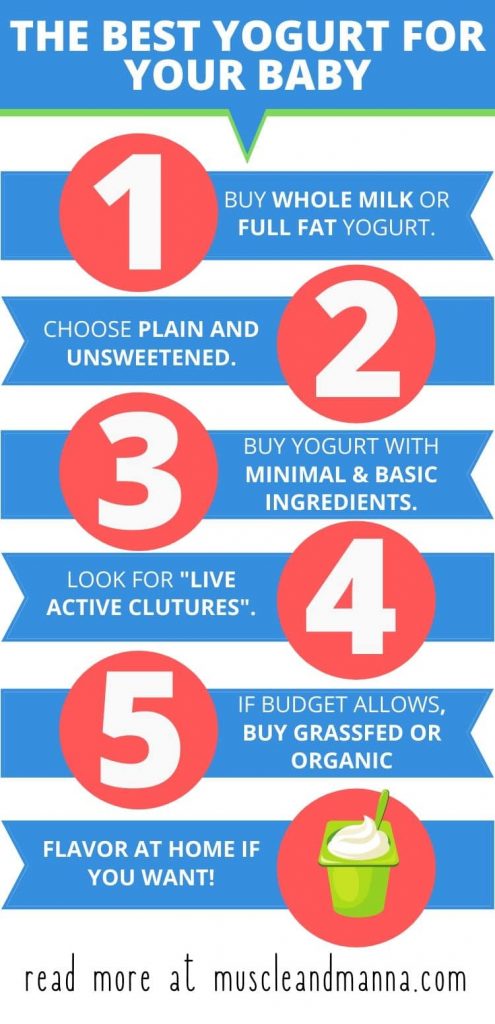
Whole Milk Yogurt for Babies
When choosing the best yogurt for babies the first thing to look for is whole milk or full-fat yogurt.
Fat is very important for brain development and before the age of 2, it’s extra important that the food the young toddler or baby eats is nourishing so that they meet their nutritional needs. Since babies and toddlers don’t eat a lot of food, the food they do eat needs to meet their nutritional requirements and every calorie should count.
The best whole milk yogurt for babies will also be free of extra ingredients and especially sweetener.
Buy Only Unsweetened Yogurt for Babies
Most (but not all) flavored yogurts have added sugar and sweetener. Look for an unsweetened plain yogurt to serve to your baby.
Because it’s so important for babies and toddlers to meet their nutritional requirements, it’s important to not fill their bellies with sweeteners and sugars that provide no nutritional value. In addition, taste is still adjusting and developing before 2. Therefore, avoiding added sugars before this time can help your child to self-regulate their consumption of sweets later in life. Lastly, chances are your baby will like yogurt plain if that is all they know.
However, while your baby may enjoy plain yogurt, you can certainly sweeten and flavor it yourself at home easily with fruits to make it more fun, especially for older babies, toddlers (and adults!) Be sure to check out the bottom of this article for our favorite ways to sweeten it in our house.
What about the sugar in “unsweetened” yogurt?
When you are purchasing plain and unsweetened yogurt, you may notice it still contains sugar if you read the nutritional label. As long as no form of sugar is listed in the ingredient label, this is not added but simply lactose, a naturally occurring sugar found in yogurt and other dairy products.
Greek vs Regular Yogurt for Babies and Toddlers
First, let’s talk about the differences between greek and regular/standard yogurt:
- Greek yogurt is strained more than standard yogurt.
- Because it has been strained more it does have less lactose and whey.
- It has more protein per serving as well due to the straining process.
- Greek yogurt is creamier and thicker. It can also be described as being more tart than standard yogurt.
So, is greek yogurt ok for babies and toddlers?
In short, yes, you can give greek yogurt to babies. However, keep in mind it does contain more protein and your baby’s main protein and calorie intake should be coming from breastmilk or formula until they are 1. Therefore, this extra protein is not necessary and you may find your baby prefers traditional yogurt since it is not as tart.
Greek yogurt can make a good protein source for a toddler who doesn’t love meat. Some older babies and toddlers will tolerate traditional yogurt better due to it’s lower protein load while others may do better with the lower whey and lactose content in greek yogurt. Not to mention, taste and preferences vary from child to child.
I personally offer my 2-year-old both a variety of greek and traditional yogurt. I chose to start him on traditional/regular yogurt. But now at around 2.5 years old, he does have a preference for the “creamy kind of yogurt” AKA greek yogurt. However, I still offer both as I want him to be exposed to a variety of foods, textures, and tastes.
Dairy Free Yogurt for Babies
There are many dairy-free yogurts now available on the market. If your baby has a milk allergy you may be wondering if a dairy-free yogurt could be right for your baby. Dairy-free yogurts are made with coconut, almond, oat and soy milk.
When choosing any yogurt (including non-dairy yogurt), read the ingredient list to minimize unnecessary additives and ensure there are no sweeteners. Often times, plant-based dairy alternatives have numerous additives in them so compare products at your local grocery store to find the best fit for your family and child.
Keep in mind that the fat content of non-dairy yogurt can differ significantly. For example, oat milk yogurt has minimal fat and therefore may not be the best choice for young babies and toddlers. Almond milk yogurt such as Kite Hill can offer more fat and protein while coconut milk yogurt such as So Delicious Coconut Yogurt offers fat but not much protein.
Best Yogurt Brands for Baby
There are many, many yogurt brands that would be great for your baby. These are just a few I’ve tried and that I’ve found easy to find at my local stores.
Best Whole Milk Yogurt for Babies and Toddlers:
- Organic Valley Grassmilk Whole Milk Yogurt
- Stonyfield Organic Plain Whole Milk Yogurt
- Simply Nature Whole Milk Plain Yogurt from Aldi
- Maple Hill Grassfed Organic Plain Yogurt
Best Greek Yogurt Brands for Babies and Toddlers:
- Maple Hill Creamery Grassfed Organic Greek Yogurt, Plain
- Fage Total 5% Whole Milk Plain Greek Yogurt
- Siggi’s Whole Milk Icelandic Yogurt
- Chobani Whole Milk Greek Yogurt, Plain
- Simply Nature Whole Milk Greek Plain Yogurt from Aldi
Healthy Budget Friendly Plain Yogurt Choices:
- Aldi Friendly Farms Whole Milk Yogurt
- Aldi Organic Simply Nature Whole Milk Yogurt
- Stonyfield Organic (often found at Walmart)
- Walmart Great Value brand Plain yogurt has no additives
Fruit Only Sweetened Yogurt for Toddlers
- Siggi’s No Sugar Added Whole Milk Yogurt – Comes in 2 flavors and is only sweetened with fruit. This is my favorite flavored yogurt for older babies and toddlers. The ingredient list is simple and the yogurt is delicious.
- FAGE Tru Blend – Again no processed sugar or artificial sweetener. It does have more ingredients than Siggi’s and is low fat. Since it’s low fat, it’s not best for littles under 2, but can work for older toddlers.
When Can Babies Have Yogurt
While you should check with your personal Registered Dietitian or Pediatrician, many experts now recommend that yogurt can be given as early as 6 months. In the past, it was recommended parents wait 8-9 months before offering any dairy. And while it still holds true that whole milk should be delayed until 1; serving yogurt earlier is ok.
In fact, research now indicates that early introduction of common allergies may actually help to prevent food allergies. In addition, some research shows that introduction of these foods while a child is still breastfeeding may actually be helpful in preventing food allergies.
The Benefits of Yogurt
Yogurt contains probiotics that help to form a healthy gut microbiota. It’s also full of nutrients such as healthy fats, protein, and calcium that help your toddler grow and develop.
Yogurt is a great first way to introduce dairy to your baby. It is often easier to digest than milk due to its live active cultures and the culturing process. Full fat yogurt can also be helpful for growing toddlers who still need plenty of healthy fat and protein.
Babies and Probiotics
Babies receive their first probiotics from breastmilk, or if you aren’t able to breastfeed, some formulas contain probiotics as well. These probiotics are important for establishing a baby’s initial microbiota. However, as your baby starts to wean, yogurt and kefir can be simple ways to supplement probiotics in your baby’s diet.
How to Serve Yogurt to Babies and Toddlers
Serving plain yogurt to babies is typically best as it gets them used to the tart flavor and not feel dependent on needing their yogurt flavored or sweetened. Generally, babies are really open to trying new foods so this is a great time to get them used to a variety of tastes and textures.
If you don’t have major allergies in your family, mixing a drop of nut butter in yogurt can be a great way to introduce nuts to your baby and hopefully help to prevent future allergies.
Yogurt can make an excellent and easy breakfast idea for toddlers or babies. However, you can easily work it into lunch or dinner as well. We love to mix plain yogurt with tuna to make a tuna salad with greek yogurt for lunch and often have it served as tzatziki along with vegetables or chicken at dinner. Basically, you can’t go wrong…breakfast, lunch, dinner, snack.
Yogurt and Baby Led Weaning
If you are doing baby-led feeding or weaning, it will take your baby time to figure out how to use a spoon. Many moms love these choomee spoons or we used these olababy silicone spoons. We also used these silicone bowls with suction to help the bowl stay in place while baby was dipping.
In the baby-led approach, you can load up the spoon and lay it in front of the baby for them to pick up or you can simply give them the spoon and likely watch them eat yogurt with their hands. Of course, we already know baby-led weaning is quite a mess so be prepared with your silicone bib and a splat mat for the floor.
Other ways to incorporate yogurt into babies meal:
- Use yogurt as a dip.
- Spread yogurt on toast, banana slices, etc.
- Incorporate the yogurt with other foods such as oats or tuna.
How to Flavor Yogurt for Toddlers (and Older Babies)
As your baby gets older and becomes a toddler, it can be fun to experiment with flavoring plain yogurt at home. Personally, I still make it a point to serve plain yogurt in addition to flavored for a variety of tastes. Here are a few foods to mix in yogurt that that your toddler may enjoy :
- Mashed banana
- Nut Butter
- Mashed or diced berries
- Chia seeds
- Avocado
- Applesauce or fruit puree
- Coconut flakes
- Serve yogurt mixed with oats like in overnight oats
- Flavored with ranch or served as tzatziki for a veggie dip.
FAQs about Yogurt for Babies
Why can babies have yogurt but not milk?
It’s recommended for babies to meet their nutritional requirements from breastmilk or formula before one. Experts worry that if babies are given milk before age one it could replace some of the breastmilk or formula a baby needs. Additionally, it can inhibit absorption of iron, a nutrient very important for babies and be more difficult for babies to digest (as compared to cultured yogurt.) Small amounts of full-fat yogurt offered as a supplement to breastmilk (or formula) are not at risk for replacing the essential breastmilk and therefore can be given before one.
What about goat milk yogurt for babies?
There are also goat milk yogurt options available such as Redwood Hill Farm yogurt if your baby can tolerate goat’s milk better than cow’s milk. Similar to when buying cow’s milk yogurt, opt for plain and whole milk yogurt when buying goat milk yogurt for babies.
What about shelf stable yogurt for kids?
Shelf stable yogurt (typically found in pouches) is made shelf-stable through a heating process that kills all of the bacteria including the beneficial probiotics. Therefore, it no longer has the live active cultures in yogurt. Additionally, often shelf stable yogurts have extra ingredients including sugar not making them a suitable choice for babies.
How much yogurt can a baby have?
The serving size of yogurt for a baby is 1/4 cup. A serving size for a toddler is 1/2 cup of yogurt.
Can I give my baby yogurt every day?
While it is okay for a baby to eat yogurt every day, experts recommend serving a variety of foods to help prevent picky eating. If you serve yogurt daily, try to serve it in a variety of different ways and remember that serving a variety of foods for each meal will help your baby have a balanced diet and feel more comfortable with different foods.
Can babies eat yogurt for breakfast?
Absolutely! Try serving yogurt a variety of times including breakfast, lunch, dinner, and snacks.

Other Ideas for Feeding Babies and Toddlers
Feeding babies and toddlers can be a challenge, but try to make it fun! If you need more help feeding your littles, be sure to grab the free toddler snack list below and check out these other helpful resources on feeding your littles!
6 Healthy Cracker Options for Toddlers
14 Breakfast Ideas for Toddlers (and Babies)
Healthy First Birthday Smash Cake
Healthy Banana Oat Pancakes for Baby
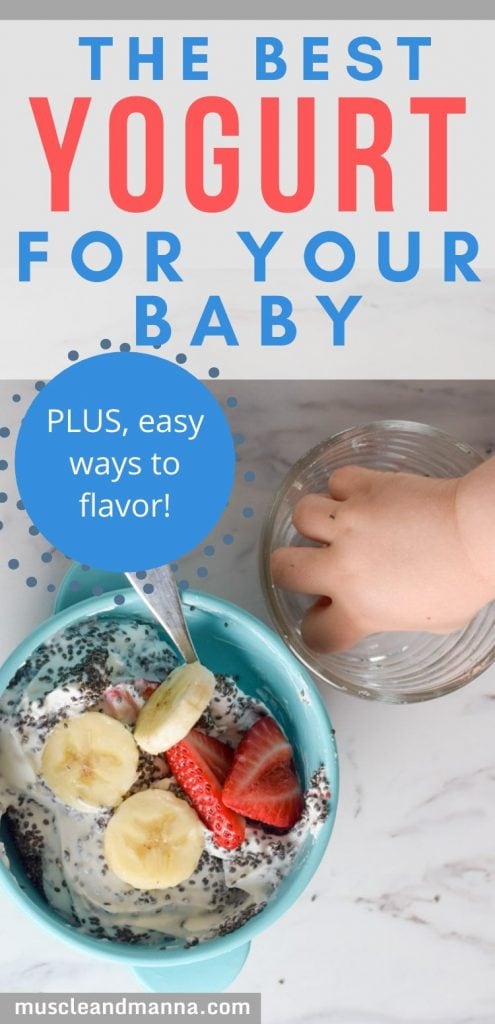
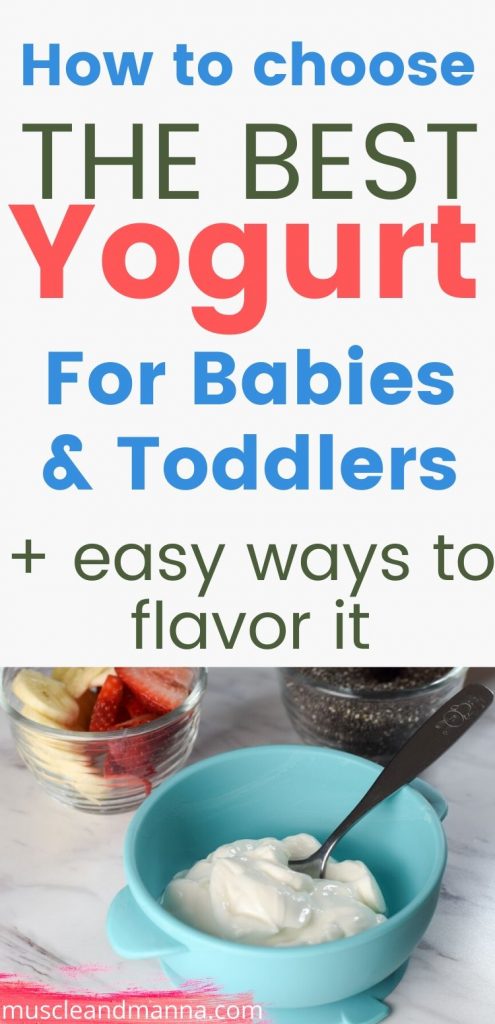
FREE Toddler Snack Printable & Grocery List
Simplify feeding your toddler with these free guides. Sign up for my email newsletter below.
